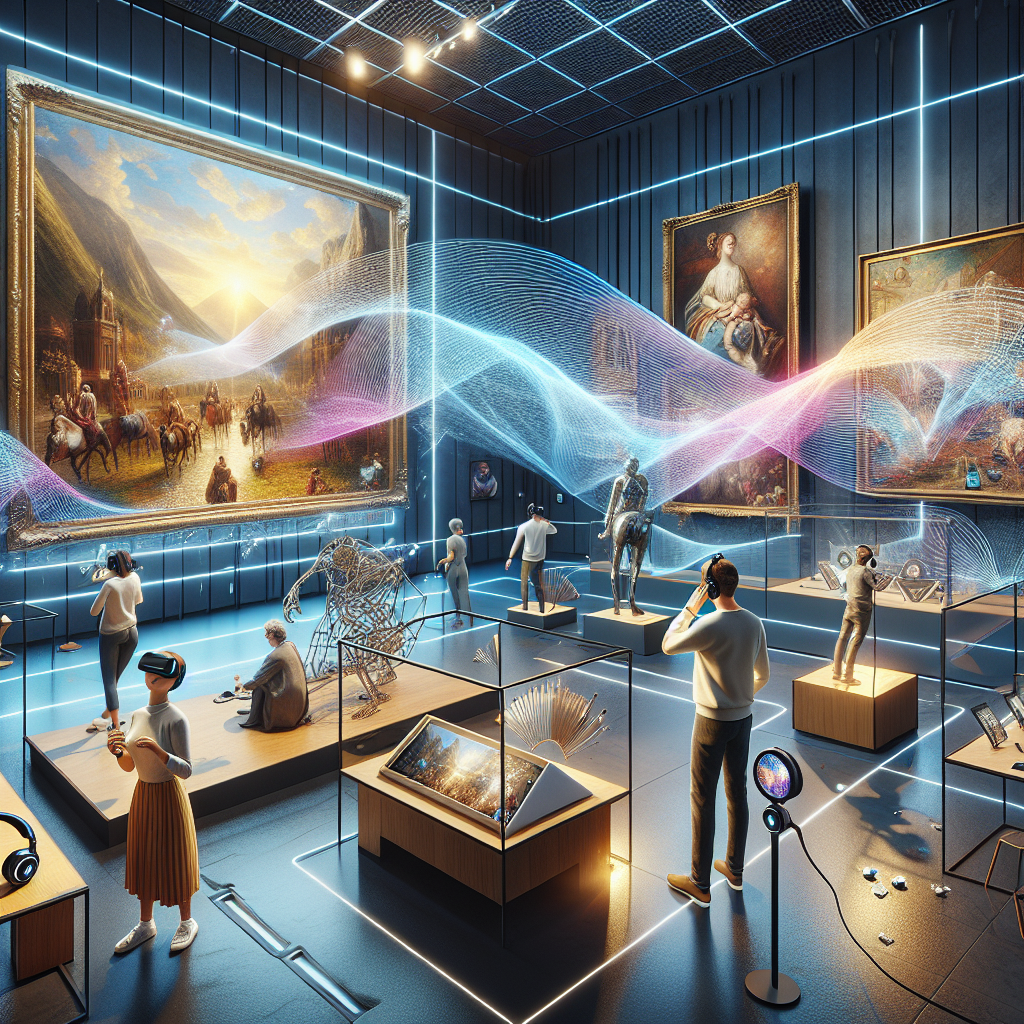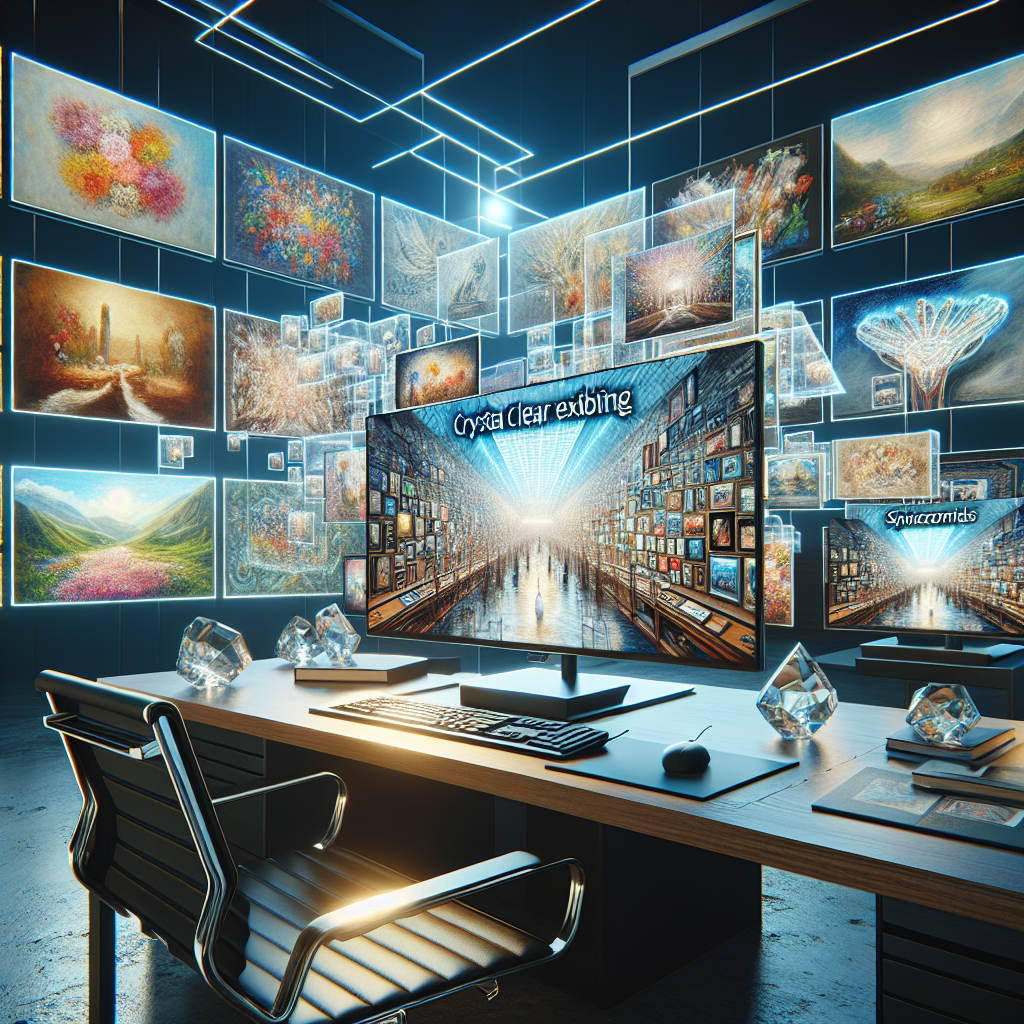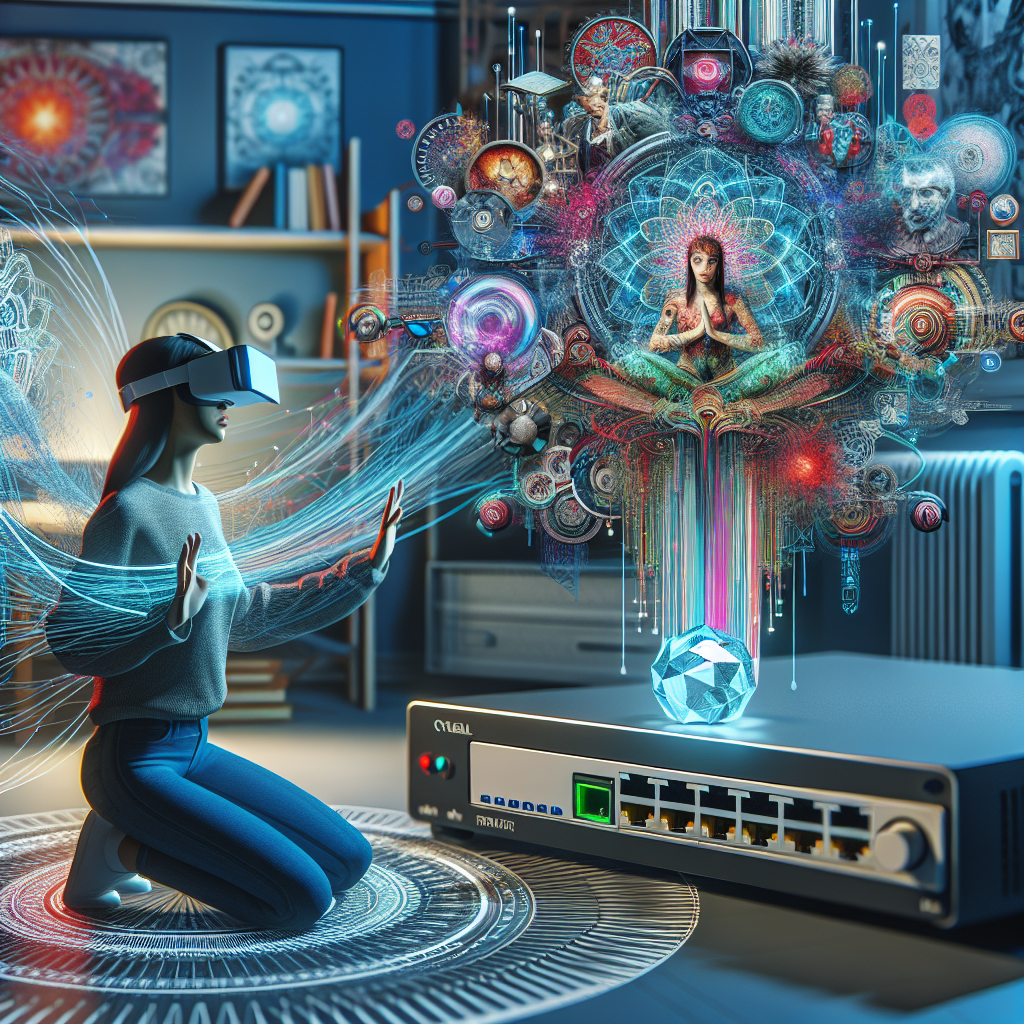Virtual exhibits have revolutionized the way we experience art and culture, allowing us to explore museums and galleries from the comfort of our own homes. With crystal clear streaming technology, these virtual exhibits are now more engaging and lifelike than ever before. From intricate details in paintings to immersive 3D tours of historical sites, viewers can now delve deep into the world of art and history with unparalleled clarity. This innovative technology brings a new level of realism to virtual exhibits, making the experience truly unforgettable. Explore the wonders of the world without leaving your couch, thanks to virtual exhibits enhanced by crystal clear streaming.
Understanding Crystal-Clear Streaming

Crystal-clear streaming refers to the high-quality transmission and display of audiovisual content over the internet with minimal disruptions or distortions. This technology ensures that the viewer experiences seamless playback of videos and images without any lagging or buffering issues.
Definition of crystal-clear streaming
- Crystal-clear streaming involves the delivery of multimedia content in high definition, allowing for sharp images, vibrant colors, and clear audio.
- It relies on advanced compression algorithms and network optimization techniques to maintain the integrity of the content during transmission.
- The goal of crystal-clear streaming is to replicate the in-person viewing experience as closely as possible, providing viewers with a sense of immersion and engagement.
Importance of high-quality streaming in virtual exhibits
- High-quality streaming is essential for virtual exhibits as it enhances the overall user experience and captivates the audience’s attention.
- Clear visuals and audio help to convey the details and nuances of the exhibited content effectively, ensuring that viewers do not miss out on any important information.
- Smooth streaming also reduces the risk of viewer frustration or disengagement, allowing them to fully appreciate and interact with the virtual exhibit without distractions.
Characteristics of Crystal-Clear Streaming
-
Resolution
Crystal-clear streaming is characterized by high resolution, typically in high definition (HD) or even ultra-high definition (UHD). The clarity of the image is crucial in virtual exhibits to ensure that viewers can appreciate the details and intricacies of the displayed items. A higher resolution provides a more immersive experience, making the virtual exhibit feel more lifelike and engaging. -
Bandwidth Requirements
Crystal-clear streaming demands significant bandwidth to deliver high-quality video content without buffering or pixelation. The higher the resolution of the stream, the more bandwidth is required to maintain the clarity of the video. Adequate bandwidth is essential for a seamless viewing experience, especially in virtual exhibits where the visual appeal plays a significant role in capturing the audience’s attention. -
Latency
In crystal-clear streaming, latency refers to the delay between the transmission of the video content and its reception by the viewer. Low latency is crucial in virtual exhibits to ensure real-time interaction and engagement. Delays or lag in streaming can disrupt the viewer experience, leading to frustration and disconnection from the exhibit. Minimizing latency is essential for creating a seamless and immersive virtual exhibit environment.
Impact of Crystal-Clear Streaming on Virtual Exhibits
Crystal-clear streaming technology has revolutionized the virtual exhibit experience, providing a range of benefits that significantly enhance the overall engagement and immersion for participants. Let’s delve into the specific impacts this technology has on virtual exhibits:
Enhanced Visual Experience
The use of crystal-clear streaming in virtual exhibits ensures that participants can enjoy high-definition visuals of the exhibits being showcased. This level of clarity allows viewers to appreciate the intricate details and nuances of the artworks or artifacts on display as if they were viewing them in person. The sharpness and vividness of the images contribute to creating a more immersive and visually stimulating experience for the audience.
Improved Engagement and Interaction
With crystal-clear streaming, virtual exhibits can offer a more interactive and engaging experience for participants. The high-quality video and audio streams enable real-time interactions, such as live Q&A sessions with curators or artists, virtual tours with expert guides, or interactive presentations. This level of engagement helps to foster a deeper connection between the viewers and the content, making the virtual exhibit more dynamic and compelling.
Real-Time Communication Benefits
One of the key advantages of crystal-clear streaming in virtual exhibits is the ability to facilitate real-time communication among participants. Whether through live chats, video calls, or interactive features, this technology enables seamless communication between viewers, exhibitors, and presenters. This real-time interaction allows for immediate feedback, questions, and discussions, creating a sense of community and shared experience among virtual exhibit attendees.
In conclusion, the impact of crystal-clear streaming on virtual exhibits is profound, enhancing the visual experience, improving engagement and interaction, and providing real-time communication benefits that elevate the overall virtual exhibit experience for participants.
Case Studies on Virtual Exhibits
Impact of Crystal-Clear Streaming on Virtual Exhibits
Museums
- The Louvre Museum in Paris, France, implemented crystal-clear streaming technology to enhance its virtual exhibits, allowing online visitors to explore famous artworks with unprecedented clarity and detail.
- Through high-quality streaming, the museum was able to provide an immersive experience for virtual visitors, enabling them to appreciate intricate details of paintings and sculptures as if they were viewing them in person.
- The crystal-clear streaming technology not only attracted a wider audience to the museum’s virtual exhibits but also received positive feedback from art enthusiasts worldwide for its ability to replicate the in-person viewing experience effectively.
Art Galleries
- The Guggenheim Museum in New York City utilized crystal-clear streaming to showcase its art collections in virtual exhibits, offering art lovers a visually stunning and interactive platform to engage with contemporary artworks.
- By incorporating high-definition streaming technology, the art gallery could present artworks in exquisite detail, allowing online visitors to zoom in on brushstrokes, textures, and color gradients that are typically appreciated in physical gallery settings.
- This innovative approach to virtual exhibits not only garnered increased online traffic for the art gallery but also received critical acclaim for its ability to deliver a seamless and enriching art-viewing experience from the comfort of one’s home.
Trade Shows
- Trade show organizers adopted crystal-clear streaming solutions to transform traditional trade show events into dynamic virtual exhibitions, enabling exhibitors to showcase products and services with unparalleled visual clarity and real-time interactivity.
- With the implementation of high-quality streaming technology, virtual trade show participants could explore booths, product demonstrations, and interactive presentations in crystal-clear resolution, fostering meaningful connections and business opportunities in a virtual environment.
- The integration of crystal-clear streaming in virtual trade shows proved to be a game-changer, as it not only replicated the immersive experience of physical trade shows but also offered a more accessible and cost-effective platform for exhibitors and attendees to engage and collaborate on a global scale.

Technical Aspects of Crystal-Clear Streaming
Crystal-clear streaming in virtual exhibits is achieved through a combination of advanced technical aspects that optimize the delivery of high-quality audio and video content to viewers.
Compression Techniques
In the realm of virtual exhibits, compression techniques play a crucial role in ensuring that content is transmitted efficiently without compromising its quality. By reducing the size of audio and video files, compression techniques such as H.264/AVC and H.265/HEVC enable smoother streaming experiences for users. These techniques involve encoding algorithms that efficiently pack data for transmission and decoding at the receiving end, resulting in crystal-clear visuals and uninterrupted playback.
Adaptive Streaming Technology
Adaptive streaming technology further enhances the viewing experience in virtual exhibits by dynamically adjusting the quality of the stream based on the viewer’s internet connection speed and device capabilities. This technology allows for seamless transitions between different bitrates and resolutions, ensuring that viewers receive the best possible quality without buffering or interruptions. By constantly monitoring network conditions, adaptive streaming optimizes the streaming experience, delivering crystal-clear content tailored to each viewer’s specific requirements.
Hardware Requirements for Optimal Streaming
To support crystal-clear streaming in virtual exhibits, specific hardware requirements must be met to ensure smooth playback and high-quality content delivery. This includes robust processors capable of handling the decoding of compressed audio and video files, sufficient RAM to buffer and store streaming data, and reliable network connectivity to transmit data seamlessly. Additionally, the use of graphics processing units (GPUs) can offload video decoding tasks from the CPU, further enhancing the streaming experience by freeing up processing power for other essential functions. By meeting these hardware requirements, virtual exhibits can leverage crystal-clear streaming to engage and captivate audiences with immersive content experiences.
Best Practices for Implementing Crystal-Clear Streaming
Technical Aspects of Crystal-Clear Streaming
Implementing crystal-clear streaming in virtual exhibits requires adherence to several best practices to ensure a seamless viewing experience for users. These practices encompass a range of technical aspects that contribute to the overall quality of the streaming content.
-
Bandwidth optimization strategies
-
Utilize adaptive bitrate streaming: Implementing adaptive bitrate streaming allows for the automatic adjustment of video quality based on the user’s internet connection speed. This ensures that viewers receive the best possible quality without buffering or interruptions.
-
Content delivery network (CDN) utilization: Leveraging a CDN helps distribute content geographically, reducing latency and ensuring faster loading times for users accessing the virtual exhibit from different locations.
-
Compression techniques: Employing advanced video compression techniques such as H.264 or H.265 can significantly reduce file sizes without compromising quality, enabling smoother streaming experiences even with limited bandwidth.
-
Quality control measures
-
Regular monitoring and testing: Conducting regular tests and monitoring the streaming quality is crucial to identify and address any issues promptly. This includes checking for audio-video synchronization, resolution consistency, and overall playback performance.
-
Encoding standards compliance: Adhering to industry-standard encoding practices ensures compatibility across various devices and platforms, maintaining consistent quality throughout the streaming process.
-
Error handling protocols: Implementing robust error handling protocols helps mitigate issues such as buffering, freezing, or sudden quality drops, providing a more reliable streaming experience for users.
-
Integration with virtual exhibit platforms
-
Seamless platform integration: Ensuring compatibility and seamless integration with the virtual exhibit platform is essential for delivering a cohesive user experience. This involves optimizing streaming settings, player configurations, and interactive features to align with the overall exhibit design.
-
Customization options: Offering customization options within the streaming interface allows users to adjust settings based on their preferences, such as playback quality, subtitles, or viewing modes, enhancing overall engagement and satisfaction.

– Interactive elements synchronization: Coordinating interactive elements within the virtual exhibit with the streaming content helps create a more immersive and engaging experience for users, fostering deeper exploration and interaction with the exhibit content.
Future Trends in Crystal-Clear Streaming for Virtual Exhibits
In the realm of virtual exhibits, the demand for crystal-clear streaming is pushing the boundaries of technology to deliver an immersive and engaging experience for users. As technology continues to advance, several future trends are emerging to enhance the quality of virtual exhibits through crystal-clear streaming:
-
360-degree streaming: One of the key future trends in crystal-clear streaming for virtual exhibits is the adoption of 360-degree streaming technology. This innovative approach allows users to explore exhibits from all angles, providing a more realistic and interactive experience. By capturing a full panoramic view of the exhibit space, 360-degree streaming enables users to feel as though they are physically present, enhancing their overall engagement and immersion.
-
Virtual reality integration: Another exciting trend in crystal-clear streaming for virtual exhibits is the integration of virtual reality (VR) technology. By combining high-quality streaming with VR capabilities, virtual exhibits can offer users a truly immersive experience that blurs the lines between the physical and digital worlds. Users can navigate virtual exhibit spaces in real-time, interact with objects, and even participate in interactive activities, all while enjoying crystal-clear streaming quality that enhances the sense of realism and presence.
-
Interactive features for enhanced user experience: In addition to advanced streaming technologies, future trends in crystal-clear streaming for virtual exhibits also focus on incorporating interactive features to enhance the user experience. From interactive touchpoints that provide additional information about exhibits to gamified elements that encourage user participation, these interactive features add depth and engagement to virtual exhibits. By combining crystal-clear streaming with interactive elements, virtual exhibits can captivate users and create memorable experiences that rival in-person visits.
As virtual exhibits continue to evolve and push the boundaries of technological innovation, the integration of crystal-clear streaming technologies will play a crucial role in enhancing the overall user experience and delivering immersive and engaging virtual experiences.
FAQs for Virtual Exhibits Enhanced by Crystal Clear Streaming
What is a virtual exhibit enhanced by crystal clear streaming?
A virtual exhibit enhanced by crystal clear streaming is a digital exhibition that is accessed online and features high-quality streaming capabilities for a more immersive and engaging user experience. It allows viewers to explore the exhibit as if they were physically present, with crisp and detailed visuals that enhance their understanding and enjoyment of the artworks or artifacts on display.
How does crystal clear streaming enhance the virtual exhibit experience?
Crystal clear streaming enhances the virtual exhibit experience by providing viewers with high-definition images and videos that showcase the exhibits in stunning detail. This allows for a more realistic and immersive exploration of the artworks or artifacts, helping viewers to appreciate the intricate details and textures of each piece. Additionally, crystal clear streaming can create a seamless viewing experience without lags or buffering, ensuring that viewers can fully engage with the exhibit without any technical interruptions.
Can virtual exhibits with crystal clear streaming be accessed on different devices?
Yes, virtual exhibits enhanced by crystal clear streaming can typically be accessed on a variety of devices, including computers, tablets, and smartphones. This flexibility allows viewers to explore the exhibit from the comfort of their own homes or on the go, making it more accessible to a wider audience. Additionally, some virtual exhibit platforms may offer compatibility with virtual reality headsets for an even more immersive viewing experience.
Are there any benefits of experiencing a virtual exhibit with crystal clear streaming compared to a physical exhibit?
One of the main benefits of experiencing a virtual exhibit with crystal clear streaming is the convenience and accessibility it offers. Viewers can explore the exhibit at their own pace and from wherever they are, without the need to travel to a physical location. Additionally, the high-quality streaming enhances the visual experience, allowing viewers to see the exhibits in greater detail than they might in person. Virtual exhibits with crystal clear streaming also have the potential to reach a larger audience and engage more people who may not have the opportunity to visit a physical exhibit.